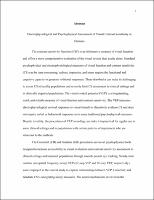Please use this identifier to cite or link to this item:
https://hdl.handle.net/20.500.12202/7147| Title: | Electrophysiological and psychophysical assessment of visual contrast sensitivity in humans |
| Authors: | Zemon, Vance Swencionis, Charles Alam, Nazia Mooney, Scott Prusky, Glen Root, Renee Migliaccio |
| Keywords: | contrast sensitivity psychophysics vision visual evoked potential gradiate neurosciences |
| Issue Date: | Sep-2021 |
| Citation: | Root, R.M. (2021, September). Electrophysiological and psychophysical assessment of visual contrast sensitivity in humans (Publication No. 28771745) [Doctoral dissertaiton, Yeshiva University].ProQuest Dissertations and Theses Global. |
| Series/Report no.: | ProQuest Theses and Dissertations Global;28771745 |
| Abstract: | Abstract The contrast sensitivity function (CSF) is an informative measure of visual function and offers a more comprehensive evaluation of the visual system than acuity alone. Standard psychophysical and electrophysiological measures of visual function and contrast sensitivity (CS) can be time-consuming, tedious, imprecise, and many require the functional and cognitive capacity to generate volitional responses. These drawbacks can make it challenging to assess CS in healthy populations and severely limit CS assessment in clinical settings and in clinically impaired populations. The visual evoked potential (VEP) is a longstanding, valid, and reliable measure of visual function and contrast sensitivity. The VEP measures electrophysiological cortical responses to visual stimuli to objectively evaluate CS and does not require verbal or behavioral responses as in many traditional psychophysical measures. Despite its utility, the procedures of VEP recording can make it impractical for regular use in some clinical settings and in populations with certain patterns of impairment who are intolerant to the methods. The Curveball (CB) and Gradiate (GR) procedures are novel psychophysical tools designed to increase accessibility to visual evaluation and contrast sensitivity assessment in clinical settings and impaired populations through smooth pursuit eye tracking. Steady-state contrast and spatial frequency sweep VEPs (C-swp VEP and SF-swp VEP, respectively) were employed in the current study to explore relationships between VEP, Curveball, and Gradiate CSFs and grating acuity measures. The neural mechanisms involved in the Curveball and Gradiate tasks were explored through comparison to VEP responses elicited from stimuli known to selectively target the magnocellular (M) and parvocellular (P) visual pathways. CSFs generated by C-swp VEP stimuli varied significantly from those generated by the CB and GR tasks. VEP CS estimates were lower than CB and GR for lower SFs and higher for higher SFs. The CSFs elicited from the CB and GR tasks showed a steep drop-off at ~ 6 cycles per degree, whereas the VEP CSFs showed a more gradual reduction in CS and generated higher CS estimates than CB and GR at SFs above ~ 6cpd. This pattern of responses suggests that the CB and GR tasks may target the M pathway, particularly at low SFs. Acuity estimates derived from SF-swp VEP and the GR task showed poor agreement. VEP grating acuity estimates were higher than those derived from GR across all participants, suggesting that at high SF, the P pathway may not be implicated in the GR tasks as it is in the SF-swp VEP. Taken together, these results suggest that the CB and GR tasks may preferentially target M pathway processing. |
| Description: | Doctoral dissertation / Open Access |
| URI: | https://hdl.handle.net/20.500.12202/7147 https://ezproxy.yu.edu/login?url=https://www.proquest.com/dissertations-theses/electrophysiological-psychophysical-assessment/docview/2600272195/se-2?accountid=15178 |
| Appears in Collections: | Ferkauf Graduate School of Psychology: Doctoral Dissertations |
Files in This Item:
| File | Description | Size | Format | |
|---|---|---|---|---|
| Root_Dissertation_Final Sept2021 OA.pdf | 2.58 MB | Adobe PDF |  View/Open |
This item is licensed under a Creative Commons License

